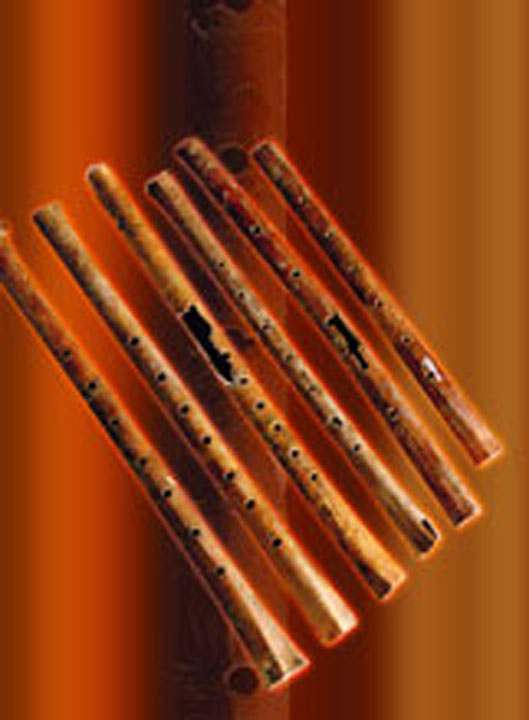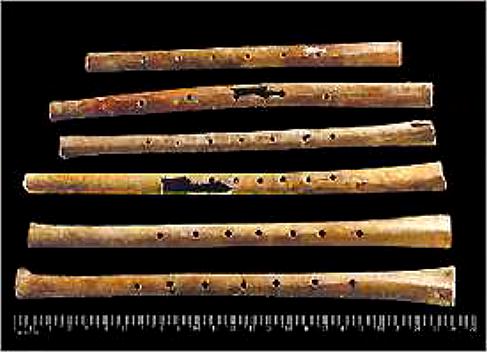
9,000 Year Old Chinese Flutes
Nature Magazine Article
 |
9,000 Year Old Chinese Flutes Nature Magazine Article |
OLDEST PLAYABLE MUSICAL INSTRUMENT FOUND AT
JIAHU EARLY NEOLITHIC SITE IN CHINA
JUZHONG ZHANG, GARMAN HARBOTTLEN, CHANGSUI WANG, &
ZHAOCHEN KONG
Institute of Cultural Relics and Archaeology of Henan Province,
Zhengzhou, Henan, China 450000
Archaeometry Laboratory, University of Science and Technology
of China, Hefei, Anhui, China 230026
Chemistry Department, Brookhaven National Laboratory, Upton,
New York 11973, USA
Paleobotany Laboratory, Institute of Botany, Academia Sinica,
Beijing, China 100080
Excavations at the early Neolithic site of Jiahu1,2 in Henan Province, China have produced what may be the earliest complete, playable, tightly-dated multinote musical instruments. Jiahu was occupied from 7000 BC to 5700 BC, considerably antedating the well known Peiligang culture3,4,5. Here we describe six exquisitely made complete flutes which were found in radiocarbon-dated excavation layers, along with fragments of perhaps 30 more. The flutes are made from the ulnae of the red-crowned crane (Grus japonensis Millen) and have 5, 6, 7 and 8 holes. The best preserved flute has been played and tonally analysed. In addition to early musical artefacts, the archaeological record at Jiahu1,2 contains important information on the very foundations of Chinese society. We describe the archaeological characteristics of the Jiahu site, details concerning its dating, its place in the prehistory of the Chinese Neolithic, the ethnicity of its population and the results of a tonal analysis of a nearly 9,000-year-old musical instrument found there.

Jiahu lies in the 'Central Yellow River Valley'3 in mid-Henan Province, east of Mount Funiu and bounded by the flood plains of the Ni river to the south and the Sha river to the north. It was discovered by Zhu Zhi in 1962 but its significance was not fully appreciated until other sites related to the Peiligang culture3,4,5 had been excavated. Jiahu is an irregular ellipse, 275 m long (east-west) and 260 m wide (north-south). Below a modern agricultural layer of loess 0.3-1.0 m deep lies a layer of the Han Dynasty (206 BC-AD 220), and beneath this Neolithic layers which together are 0.5-0.9 m thick. Of Jiahu's 55,000 m2, only 2,400 m2 (4.4%) have been excavated, revealing 45 house foundations, 370 cellars, 9 pottery kilns, more than 300 graves and thousands of artefacts made out of bone, pottery, stone and other materials. There are three sub-periods at Jiahu; during the latest two the site shows distinct areas for residences, workshops and graves1. The differential furnishing of the graves provides evidence for early social stratification. Jiahu appears to represent an organized, well established sedentary village of long duration in the very early Chinese Neolithic.
The dating of Jiahu is crucial. So far we have determined twenty
14C dates: ninefrom charcoal (three in each of the three sub-periods
mentioned above), five from plant ash, four from human bone, one
from a whole fruit pit and one from a broken grain of carbonized
rice. The conventional 14C ages range from 7,017 to 8,285 14C
years BP. After dendrochronological correction the corresponding
range is 7,700 to 9,000 calendar years BP or nearly 5700 to 7000
cal. (calibrated) BC. The three sub-periods are dated as follows:
the oldest is 6600-7000 cal. BC; the second oldest 6200-6600 cal.
BC; and the third 5700-6200 cal. BC. Thus, Jiahu spans some 1,300
years. If this range of dates is borne out by subsequent research,
then Jiahu represents a Neolithic cultural phase distinctly earlier
at its inception than the Peiligang culture, where the dates of
many of the sites range from 5100 BC to 6300 BC3,4,5. On the basis
of these dates, and considering the repertoire of ceramic shapes
and stone tools1, we would tentatively characterize Jiahu as a
culture parallel to, overlapping in duration, and very possibly
related to, the Peiligang. The same might apply to the site of
Houli in the eastern Yellow River Valley (north-central Shandong
Province), dated 5000 BC to 6200 BC3. For the 14C determinations,
see Supplementary Information.
A careful study of the bones of 400 individuals removed from more
than 300 graves indicates that the Jiahu ethnic group may be identified
with the North Asian Mongolian group, and also with the Xiawanggang
and Miaodigou groups in Henan Province and the Dawenkou, Yedian
and Xixiahou groups that were later found in Shandong Province.
The range of male heights was from 170 to 180 cm. In the late
Palaeolithic Zhoukoudian Cave, 'unspecialized' Mongoloids were
described6. By the Yangshao period (3000 BC-5000 BC)7, the skull
measurements are 'physically Chinese' and 'modern'6. The physical
similarity of the Jiahu people to the later Dawenkou (2600 BC-4300
BC) indicates that the Dawenkou might have descended from the
Jiahu, following a slow migration along the middle and lower reaches
of the Huai river and the Hanshui valley.
The discovery of complete, playable multinote flutes at Jiahu
presents us with a rare opportunity to hear and analyse actual
musical sounds as they were produced nine millennia ago. Earlier
flutes have been found in Neanderthal*(BELOW) contexts, but they
are so fragmentary that it is difficult to do more than guess
their tonal production8,9,10. We arranged to test one or more
of the six flutes discovered at Jiahu; all are of the vertically
held type (Sachs-Hornbostel11 classification 421.111.12).
The best preserved flute (M282:20; Fig. 1), which was free of
cracks, was chosen to be tested using a 'Stroboconn' sound-analysing
stroboscope, supervised by Huang Xiangpeng from the Music School
of the Art Institute of China. This flute has seven main holes
plus a tiny hole near hole 7. Two other seven-holed flutes were
considered, but playing tests produced cracking sounds and were
promptly discontinued. However, data were recorded for two players
blowing twice each with their embouchures angled at 45·
up and 45· down across the mouth of flute M282:20 (eight
scales altogether).
The music research team did not use the modern standard of A4
= 440 Hz, but instead adopted an arbitrary standard of hole 5
= 'C6'. (Based on A4 = 440 Hz, the actual tone of hole 5 was C6
+ 2 Hz(20 Hz), averaged over eight trials.)
Then the interval relationships of the sounds from hole 3 to hole
7 fitted reasonably well to the note sequence E6, D6, C6, B5,
A5, with the tone of hole 1 = A6 and hole 2 = F#6. On this scale,
the tone of the whole tube is G5 or F#5. In Table 1 three of the
intervals in M282:20 are evaluated numerically.
TABLE1: Location Av'g value (Cents) Description
---------------------------------------------------------------------------------
Btwn hole 1&2 284 minor 3rd
Btwn hole 2&3 244 >maj2nd (whole tone)
Btwn hole 7&tube 260 <minor 3rd but >whole tone
Tests revealed that the tiny hole next to hole 7 (Fig. 1) was
probably drilled to correct the off-pitch tone of the original
hole 7; thus a tone of G#5 + 16 Hz was corrected to A5 - 11 Hz,
which is much closer to the octave of A6 - 36 Hz.
Without testing more flutes, we cannot say whether the tonal scale
of the bone flute of Jiahu (M282:20) is the ancestor of either
the six-tone Qing Shan scale or the seven-tone Xia Shi scale;
in any case, the latter two scales are only documented six millennia
later. It should be possible, by constructing exact replicas of
the Jiahu flutes in material whose density approximates bird-bone,
to study the tonal sequences of all these instruments without
endangering the valuable artefacts themselves. The carefully selected
tone scale observed in M282:20 indicates that the Neolithic musician
of the seventh millennium BC could play not just single notes,
but perhaps even music. It is important in considering the possible
role of these flutes in Neolithic society to recall that ancient
Chinese tradition held that there were strong cosmological connections
with music: that music is part of nature12. In this context, the
performance of rituals and music were specifically associated
with matters of state and sound government13.
Excavation of only a small fraction (<5%) of the Jiahu site
has revealed that, by the unexpectedly early date of 7000 BC,
a complex, highly organized Chinese Neolithic society had already
begun to evolve employing multinote musical instruments. Future
excavation and research should help us to understand the technical
aspects of one of mankind's earliest practices of musical expression,
which probably took place in a ritual setting.
Note added in proof: Flute M282:20 can be heard on the Nature
web site. In the recording, made at the Music Institute of the
Art Research Institute of China, Taoying Xu plays part of the
folk song "Xiao Bai Cai" ("The Chinese small cabbage").
Recording engineer was Bobao Gu. Research for the recording was
by Xiangpeng Huang (deceased), Xinghua Xiao and Zhongliang Tong.
Supplementary Information is available at Nature's World-Wide
Web site (http://www.nature.com) or as paper copy from the London
editorial office of Nature. References
1.Henan Province, Institute of Cultural Relics. Preliminary report
for the second through the sixth excavation at the Neolithic site
of Jiahu in Wuyang, Henan. Wenwu 1, 1-17 (1989). Links Save Citation
2.Zhang, J. & Wang, X. Notes on the recent discovery of ancient
cultivated rice at Jiahu, Henan Province: a new theory concerning
the origin of Oryza japonica in China. Antiquity 72, 897-901 (1998).
Links Save Citation
3.Underhill, A. Current issues in Chinese Neolithic archaeology.
J. World Prehist. 11, 103-160 (1997). Links Save Citation
4.An, Z. Radiocarbon dating and the prehistoric archaeology of
China. World Archaeol. 23, 193-200 (1991). Links Save Citation
5.National Bureau of Cultural Relics Board. A Compilation of Cultural
Areas in China (Zhongguo Ditu, Press, Henan, 1991). Links Save
Citation
6.Howells, W. W. in The Origins of Chinese Civilization (ed. Keightley,
D. N.) (Univ. of California Press, Berkeley, 1983). Links Save
Citation
7.Barnard, N. in The Origins of Chinese Civilization (ed. Keightley,
D. N.) (Univ. of California Press, Berkeley, 1983). Links Save
Citation
8.Marcuse, S. A Survey of Musical Instruments (Harper & Row,
New York, 1975). Links Save Citation
9.*Early Music. Science 276, 205 (1997). Links Save Citation (This
link reproduced below)
10.Lau, B., Blackwell, B. A. B., Schwarcz, H. P., Turk, I. &
Blickstein, J. I. B. Dating a flautist? Using ESR (electron spin
resonance) in the Mousterian cave deposits at Divje Babe I, Slovenia.
Geoarchaeology 12, 507-536 (1997). Links Save Citation
11.Brown, H. M. in The New Grove's Dictionary of Music and Musicians
(ed. Sadie, S.) 664-681 (Macmillan, London, 1987). Links Save
Citation
12.Pian, R. C., Kishibe, S. & Yang, B. N. in The New Grove's
Dictionary of Music and Musicians (ed. Sadie, S.) 245-283 (Macmillan,
London, 1987). Links Save Citation
13.Needham, N. J. T. M., Wang, L. & Robinson, K. G. in Science
and Civilization in China iv/1 (ed. Needham, N. J. T. M.) 126-228
(Cambridge University Press, 1962). Links Save Citation
14.Lindley, M. in The New Grove's Dictionary of Music and Musicians
(ed. Sadie, S.) 277-279 (Macmillan, London, 1987). Links Save
Citation
Acknowledgements. This project was supported by the National Natural
Science Foundation of China. In addition, C.W. was supported by
the Department of Science & Technology of China, the Chinese
Academy of Sciences and the Structure Research Laboratory at USTC.
Research at Brookhaven National Laboratory is supported by the
US Department of Energy. We thank Huang Xiangpeng of the Music
School of the Art Institute of China who supervised these important
tests and the personnel of the same Music School who carried them
out: Xiao Xinghua, Xu Taoying, Gu Bobao, Tong Zhongliang, Qiu
Ping and Liu Haiwang.
Correspondence should be addressed to G.H. (e-mail: [email protected])
and requests for materials should be addressed to J.Z. For further
information see http://www.pubaf.bnl.gov/pr/newsreleases.html
Nature Magazine
(c) Macmillan Publishers Ltd 1999 Registered No. 785998 England.
[Footnote numbers are not shown as raised numbers, but as: 1,2,
etc.]
Learn more about Archeological Flutes |